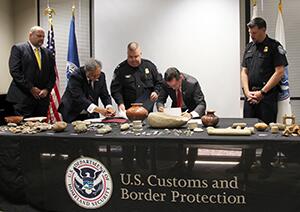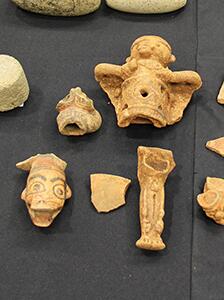MEMPHIS, Tenn. — U.S. Customs and Border Protection (CBP) officers and Homeland Security Investigations special agents repatriated cultural artifacts, some dating back to 900 B.C., to the Government of Mexico today at CBP’s Area Port of Memphis, Tenn.
During the repatriation ceremony, CBP Area Port Director Michael Neipert presented 281 pieces of Mexican artifacts to Ambassador Carlos Giralt-Cabrales of the Consulate of Mexico in Little Rock, Ark.
Special agents from Homeland Security Investigations (HSI) in Memphis participated in the repatriation. CBP partners with HSI in the detection, interception, investigation, and repatriation of cultural property. Read more about HSI Cultural Property, Art, Antiquities Program investigations.
The seven shipments arrived from Mexico between 2016-2021, and were destined to addresses in California, South Carolina, and Florida. CBP officers suspected the products to be cultural artifacts and detained them. Officers then solicited assistance from HSI agents and the Government of Mexico officials who identified the products to be cultural artifacts of Mexico.
These nine shipments of artifacts included Olmec stature, Olmec figures, tubular beads, zoomorphic amulet, body adornments, bowls, earflares, human head amulet, temple effigy, prismatic blades, basalt grinding stone, tripod glass with lid, hand grinding stone, flint projectile points, carved obsidian, clay anthropomorphic figurines, clay and stone earmuffs, metallic ring string, stone spindle, clay winch, jars, sea snail shell fragments, vase and copper rattle.
Working with CBP’s Office of International Affairs and the Government of Mexico, CBP Area Port Director Neipert’s staff initiated the repatriation process, which led to Wednesday’s ceremony.
“On behalf of U.S. Customs and Border Protection, I am honored to return these priceless national treasures to the government and citizens of Mexico,” said Michael Neipert, CBP’s Area Port Director in Memphis. “Customs and Border Protection will continue to use our border authority to identify, rescue, and return precious antiquities being smuggled by those who profit on the theft of another country’s historical and cultural property.”
Most countries have laws that protect their cultural property, such as art, artifacts, antiquities, or other archeological and ethnological material. These laws include export controls and national ownership of cultural property.
These bilateral agreements protect cultural property by restricting U.S. import of certain categories of archeological and ethnological material, thus reducing incentive for looting at heritage sites. Read more about these bilateral agreements on importation of cultural property.
Therefore, although they do not necessarily confer ownership, consignees or importers must have documents such as export permits and receipts when importing such items into the United States.
CBP’s border security mission is led at our nation’s Ports of Entry by CBP officers and agriculture specialists from the Office of Field Operations. CBP screens international travelers and cargo and searches for illicit narcotics, unreported currency, weapons, counterfeit consumer goods, prohibited agriculture, invasive weeds and pests, and other illicit products that could potentially harm the American public, U.S. businesses, and our nation’s safety and economic vitality.
See what CBP accomplished during “A Typical Day” in 2022. Learn more about CBP at www.CBP.gov.
Follow the Director of CBP’s New Orleans Field Office on Twitter at @DFONewOrleans for breaking news, current events, human interest stories and photos, and CBP’s Office of Field Operations on Instagram at @cbpfieldops.

